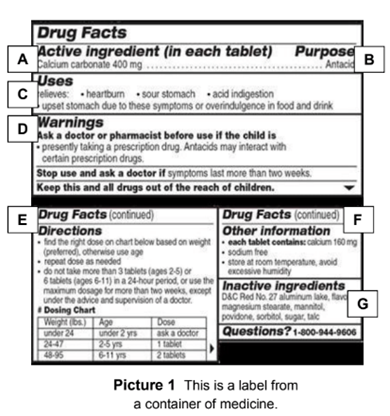How to Read a 'Drug Facts' Label

Every over-the-counter (OTC) medicine you can buy at the store must include a ‘drug facts’ label. This label has information about what the medicine does and how to use it safely. See Picture 1 below.
Drug facts
Active ingredients (A)

This section tells you the part of the medicine that makes it work. This is called the active ingredient, or the ‘generic’ name for the medicine. The ‘brand name’ is the more common name for the medicine. For the medicine shown, ‘calcium carbonate’ is the generic name, and the brand name is ‘Children’s Pepto®’.
Purpose (B)
This section is found next to the Active ingredient section. This tells you what the active ingredient will do when you take the medicine. If you do not know this word, look under ‘Uses’ (C) to see what symptoms the medicine treats. Either of these sections will help you decide if the medicine is the right thing to give your children based on how they are feeling.
Uses (C)
This part of the label tells you the symptoms the medicine treats. The medicine treats. The medicine in the picture treats a sour stomach, heartburn, or upset stomach caused by eating too much.
Warnings (D)
This section tells you about certain diseases or other drugs that make this medicine unsafe to use. If your child has a disease or takes a medicine listed in this section, talk to the doctor before giving this medicine to your child.
Directions (E)
This section tells you how to give your child the medicine. It tells you how much to give, how often to give it, and how long it can be used. Many medicines for children are given based on the child’s weight. Make sure you know how much your child weighs so that you can pick the right dose. Other medicines are given based on age. For these medicines, you can figure out how much to give by following the directions for your child’s age range.
Some medicines are not safe to be given to children unless a doctor says so. For example, the medicine in the picture should not be given to children under 2 years old.
Other information (F)
This tells you how the medicine should be stored so that it does not go bad. It also tells you more information on what the medicine does and does not contain.
Inactive ingredients (G)
This section tells you the parts of the medicine that are not active in your body. These ingredients do not make the medicine work, but some may cause an allergic reaction. Check this section to see if your child is allergic to any of the ingredients, like lactose or red dye. If so, do not give the medicine to your child.
Ask your doctor or pharmacist
- The drug facts label may look a bit different on every medicine. It may be printed larger or smaller. It also may wrap around several sides of the box or bottle.
- If you ever have trouble reading a drug facts label or do not understand part of it, make sure to ask your doctor or pharmacist. They can help explain the information on the label so you can make sure you give your child medicine that is safe and effective.
HH-IV-179 7/17 Copyright 2017, Nationwide Children's Hospital
